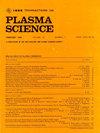四氟化碳中单频电容耦合等离子体的自动数值阻抗匹配
IF 1.5
4区 物理与天体物理
Q3 PHYSICS, FLUIDS & PLASMAS
引用次数: 0
摘要
阻抗匹配网络和等离子体之间的相互作用具有非线性动力学特征,在优化等离子体负载的吸收功率和最小化反射功率方面起着关键作用,特别是在电容耦合等离子体(CCP)放电机制的背景下。在本研究中,我们研究了电负性气体CF4在电路适当匹配条件下的放电机理。此外,我们还引入了玻尔兹曼项来分析放电模式的转变。结果表明,通过对外部电路元件参数的迭代更新,可以大大减小反射系数,找到最优匹配参数。在激活匹配网络和不激活匹配网络的情况下,等离子体放电显著增强,同时达到稳定状态所需的时间显著缩短。在不同的初始电压和压力下,研究了匹配后放电模式的转变。本文提出的方法为CCP系统内匹配电负性气体排放提供了有价值的设计参考。本文章由计算机程序翻译,如有差异,请以英文原文为准。
Automatic Numerical Impedance Matching of Single-Frequency Capacitively Coupled Plasmas in Carbon Tetrafluoride
The interaction between impedance matching networks and plasmas, characterized by nonlinear dynamics, plays a critical role in optimizing the absorption of power delivered to plasma loads and minimizing the reflected power, particularly in the context of capacitively coupled plasma (CCP) discharge mechanisms. In this study, we examine the discharge mechanism of the electronegative gas CF4 under the conditions where the circuit is properly matched. In addition, we incorporated a Boltzmann term to analyze the transition of discharge modes. The results indicate that iterative updates to the parameters of external circuit components can substantially diminish the reflection coefficient and find the optimal matching parameters. Comparison of operations with and without the activated matching network illustrates that plasma discharge is significantly enhanced with the matching network engaged, accompanied by a notable reduction in the time required to attain steady state. Investigation into the transition of discharge modes following matching has been conducted by varying initial voltages and pressures. The methodology presented in this article offers a valuable design reference for matching electronegative gas discharges within CCP systems.
求助全文
通过发布文献求助,成功后即可免费获取论文全文。
去求助
来源期刊

IEEE Transactions on Plasma Science
物理-物理:流体与等离子体
CiteScore
3.00
自引率
20.00%
发文量
538
审稿时长
3.8 months
期刊介绍:
The scope covers all aspects of the theory and application of plasma science. It includes the following areas: magnetohydrodynamics; thermionics and plasma diodes; basic plasma phenomena; gaseous electronics; microwave/plasma interaction; electron, ion, and plasma sources; space plasmas; intense electron and ion beams; laser-plasma interactions; plasma diagnostics; plasma chemistry and processing; solid-state plasmas; plasma heating; plasma for controlled fusion research; high energy density plasmas; industrial/commercial applications of plasma physics; plasma waves and instabilities; and high power microwave and submillimeter wave generation.
 求助内容:
求助内容: 应助结果提醒方式:
应助结果提醒方式:


